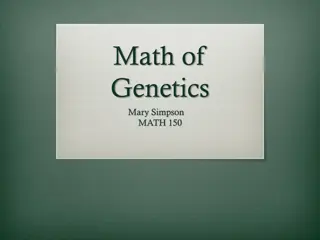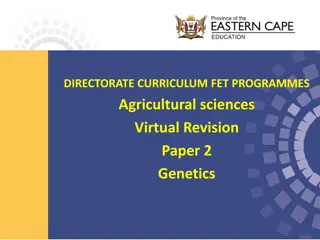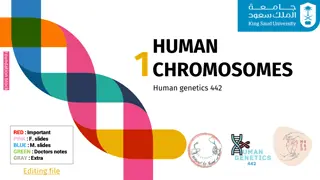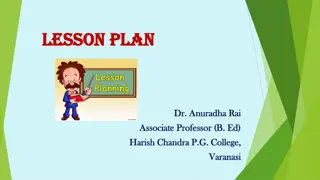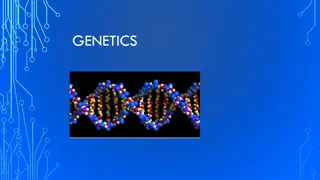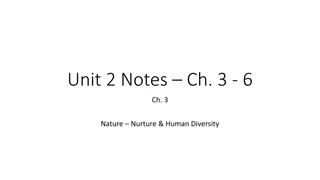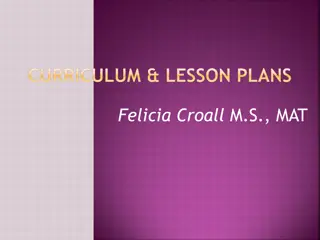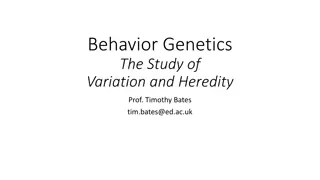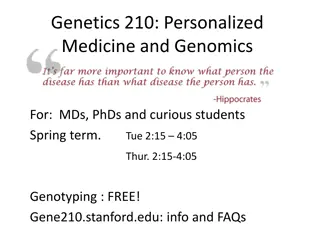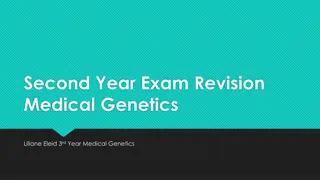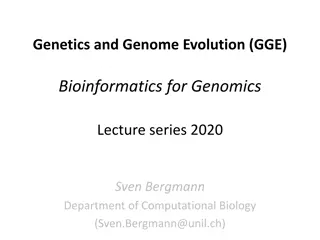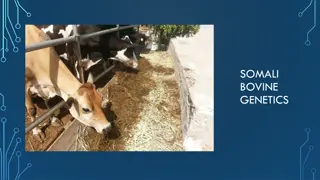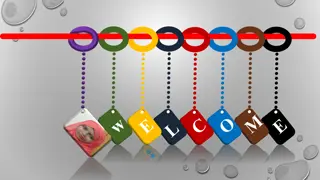Genetics Lesson Plans and Activities for High School Science Class
Explore a week's worth of engaging genetics lesson plans for high school science classes, covering DNA replication, gene expression, transcription, and translation. Get ready for quizzes and activities on DNA structure and replication, and discover the fascinating world of genetics through hands-on learning experiences.
Uploaded on Oct 09, 2024 | 0 Views
Download Presentation

Please find below an Image/Link to download the presentation.
The content on the website is provided AS IS for your information and personal use only. It may not be sold, licensed, or shared on other websites without obtaining consent from the author. Download presentation by click this link. If you encounter any issues during the download, it is possible that the publisher has removed the file from their server.
E N D
Presentation Transcript
HAPPY MONDAY 3/20 HAPPY MONDAY 3/20 Go over science/CTE credit options for next year (25 minutes) Origami Extra Credit (15 minutes) Review DNA replication and quiz each other - Can you answer: What is it? Where does it take place? When does it happen? Why does it happen? Can you name and identify all of the structural components of DNA (deoxyribose sugar, phosphate, hydrogen bonds, bases/nucleotides: ATCG)? QUIZ FRIDAY over DNA structure and DNA replication Review DNA replication processing activity (15 minutes)
HAPPY TUESDAY 3/21 HAPPY TUESDAY 3/21 Take out notebooks and find GREEN SPIDER STAMPS To be replaced with BLUE BUTTERFLIES (last assignment for notebook check) NOTEBOOK CHECK next WEDNESDAY, MARCH 29 Prepare notebook for Gene Expression Lecture (Day 2) Friendly reminder, QUIZ: DNA structure/DNA replication Friday, 3/24. QUIZ: Transcription/Translation Tuesday, 3/28. TEST: Molecular Genetics Thursday, 3/30
Whats next? What s next? After DNA Replication, there is enough DNA make 2 new cells and then again, and again until the organism stops performing cell division (i.e., never, really). Once a new cell is made, it can begin to use the DNA to create phenotypes. We call this next part Gene Expression, or the production of a phenotype given information from the genotype ( gene = segments of DNA) and it can be divided into 2 steps: Transcription and Translation.
Transcription Transcription Produces a RiboNucleic Acid (single) strand using a DNA template DNA is read from 3 5 ( template strand) Transcription enzyme = RNA Polymerase Takes place in the nucleus In gene expression, mRNA is made Base pair rules: C G G C T A A U
Lets Transcribe! Let s Transcribe! 5 TCATGCAGAGGAGATTAA 3 3 AGTACGTCTCCTCTAATT 5 Gene Template mRNA 5 3 5 GATCAGGGAGACTTAGCA 3 3 CTAGTCCCTCTGAATCGT5 Gene Template mRNA 5 3
HAPPY WEDNESDAY! 3/22 HAPPY WEDNESDAY! 3/22 Finish Gene Expression notes (15 minutes) Transcription/Translation Activity (35 minutes) HOMEWORK: Gene Expression Practice worksheet
Translation Translation Produces an amino acid sequence using mRNA as a template mRNA is read from 5 3 in triplets ( codons ) Codons code for amino acids Start codon is AUG but stop codon varies Enzyme that does this is called tRNA Takes place in cytoplasm at a ribosome After folding of polypeptide, a protein is formed!
The Genetic Code The Genetic Code Examples: AUG is Met (start) ACC is Thr AGA is Arg! UAA is Stop UAG is Stop UGA is Stop
Use the Genetic Code to figure out what amino acids are assembled based on mRNA strand Alanine Threonine Glutamate Leucine Arginine Serine Stop!
Once the amino acid sequence is complete, it folds into a 3D glob = a protein Proteins do all of our cellular work, so they create phenotypes. a protein! Discuss with a neighbor: How do you get from genotype to phenotype?
Translation: Translation: 5 GATCATGCGTCTCCTCTAATT3 Gene Template mRNA Amino Acids
Your Task Your Task Step 1: Find a partner and complete the following activity in your notebook Step 2: Select a gene coding strand of DNA from the class nucleus (big desk at the front of the room) Create the complimentary DNA template strand Step 3: Transcribe the DNA template strand into mRNA codons Step 4: Translate mRNA codons into tRNA anti-codons Go to the lab stations and find your anti-codons Write the word from the back of your anti-codon in your notebook. By the end of the sequence you should have a funny sentence. Gene Expression Practice Worksheet for homework tonight
HAPPY THURSDAY! 3/23 Remember, QUIZ TOMORROW over the structure of DNA and DNA Replication (NOT transcription/translation- that s Tuesday!) Self-assess HW: Gene Expression Practice WS- KEY ONLINE Pre-lesson Activity (5 minutes) Mutation Notes (40 minutes) Post-lesson Activity (5 minutes) MOLECULAR GENETICS TEST ONE WEEK FROM TODAY! (3/30)
Mutations Adapted from: National Science Foundation GK-12 and Research Experience for Teachers (RET) Programs, University of Houston https://www.teachengineering.org/lessons/view/uoh_mutations_lesson01
Superheroes How did Cyclops from the X-Men get his superpowers? He was born with the mutation How did the Hulk and Spiderman get their superpowers? The Hulk was exposed to gamma radiation and Spiderman was bitten by a radioactive spider
Learning about Mutations Types of mutations and how they occur How environmental factors influence mutations Effects of mutations
Types of Mutations Small-scale mutations Affect DNA at the molecular level by changing the normal sequence of nucleotide base pairs Occur during the process of DNA replications (either meiosis or mitosis) Normal DNA CAT AAG TAT CCT GTA Protein His Lys Tyr Pro Val
#1 Small-Scale Mutations 1. Substitution (or a point mutation) Substitutions occur when a nucleotide is replaced with a different nucleotide in the DNA sequence This type of mutation only affects the codon for a single amino acid Substitution CAT AAG TAT CGT GTA Protein His Lys Tyr ARG Val
#2 Small-Scale Mutations 2. Deletion (a frameshift mutation) Deletion is the removal of a nucleotide from the DNA sequence Removal of even a single nucleotide from a gene alters every codon after the mutation Deletion C_TC AAG TAT CTA TA Protein Leu Arg Tyr Leu
#3 Small-Scale Mutations 3. Insertion (a frameshift mutation) Addition of a nucleotide to the DNA sequence Addition of even a single nucleotide to a gene alters every codon after the mutation Insertion CAT TAA A TAT CGC GGT Protein His Stop Tyr Arg Gly
Large-Scale Mutations Affect entire portions of the chromosome Some large-scale mutations affect only single chromosomes, others occur across nonhomologous pairs Entire genes or sets of genes are altered rather than only single nucleotides of the DNA Mutations involving multiple chromosomes are likely to occur in meiosis.
Large-Scale Mutations Nondisjunction Does not involve any errors in DNA replication or crossing-over Mutations occur when the chromosomes are not separated correctly into the new cells Common nondisjunctions are missing or extra chromosomes
Effects of Mutations The effects of mutations may range from nothing to the unviability of a cell All mutations affect the proteins that are created during protein synthesis, but not all mutations have a significant impact
Small-Scale Mutation Effects 1. Silent The nucleotide is replaced, but the codon still produces the same amino acid 2. Missense The codon now results in a different amino acid, which may or may not significantly alter the protein s function 3. Nonsense The codon now results in a stop command, truncating the protein at the location where the mutated codon is read; this almost always leads to a loss of protein functionality
Large-Scale Mutation Effects Often, large-scale mutations lead to cells that are not viable The cell dies due to the mutation
Mutation Influences Exposure to certain chemicals Carcinogenic chemicals may cause cancer Exposure to radiation Retroviruses Retroviruses such as HIV naturally experience mutations at a much higher rate than other organisms
Engineering Connection Humans have been genetically modifying plants and animals for thousands of years Example: Breeding watermelons to be larger and have fewer seeds Example: Breeding chickens to have more white meat and more breast meat
Engineering Connection Engineers can directly manipulate the genetic code of plants and animals (controversial) Examples: Disease-resistant papaya, vitamin A-rich rice, and drought-tolerant corn Engineers and scientists are currently studying gene editing in the womb May prevent the child from having diseases and disabilities
HAPPY FRIDAY! 3/24 Clear Desks for DNA Structure and DNA Replication QUIZ (15 minutes) When finished, submit quiz to green box Complete Post Lesson Activity (Tiger Sheet) and submit to green box when finished CODON BINGO Prizes MONDAY! MOLECULAR GENETICS TEST NEXT THURSDAY (3/30)
Translation: Translation: 5 3 CTCATACGGACAGTATTTTAC5 3 Gene Template mRNA Amino Acids
Discuss with your neighbors: Discuss with your neighbors: 1. Where does DNA Replication take place? 2. Where does Transcription take place? 3. What does Transcription produce? 4. Where does Translation take place? 5. What does Translation produce? 6. The Genetic Code is used to figure out what amino acids are assembled based on the from the ______ strand strand created


